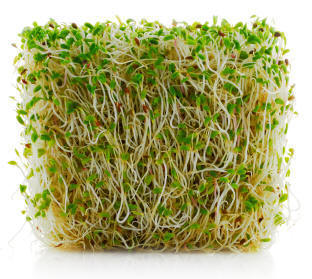Hello, class! Welcome back to your final Whole Grains class. I know you’ve been riveted waiting for this!
Pop quiz:
- What are the three edible parts of a grain?
- What are the two power-packed parts that are usually reduced or removed when processing for refined, white flour products?
- What should the first ingredient be when choosing a Whole Grain food product? What should it NOT be?
- What types of oats should you avoid due to sugars and other additives?
- You’re not actually planning to write out answers to these, are you?
I hope maybe you can recall at least a few of those answers! But if not…
1) bran, germ, endosperm
2) brand, germ
3) “whole” ___ (wheat flour, oat flour, etc) not “Refined” or “enriched”
4) flavored instant oats! (Oat groats are the least processed, followed by steal-cut, then you get into your rolled oats and quick-cookers. These are all healthy!)
5) probably not 😉
Now on to sprouting!

Sprouting seeds and grains for nutrition is a concept I came across a few years ago, when I was studying different type of diets. Raw foodists will not cook food, so when it comes to grains, they will often soak them to the point that the little germ begins to grow a tail. It sprouts! (Remember, the germ is the baby seed within the kernel that can grow another plant.) The theory is that is has all this awesome nutritional power locked in that seed – after all, it has to grow another plant. (Though usually, you grow your seed in nutrient-rich soil, so, sometimes foodies grow their sprouts in little trays of soil – but that’s more intensive.)
Remember the old school days when you took a sunflower seed, laid it on a damp paper towel, then pressed it against a clear cup so you could see it? Eventually, it began to sprout and grow into a sunflower. It’s the same concept: using water to begin the growth process of the plant, since the seed has growth-inhibitors on it allowing it to remain dormant until it is time to stretch for the sun and grow. However, in sprouting, instead of letting the seed fully grow into a new plant, once the tail has grown a bit (anywhere from a few centimeters to a few inches) people will eat them. They may be added to salads, sandwiches, wraps, smoothies…

Picture from yasmeen-healthnut.blogspot.com
Since at first I had only seen raw foodists promoting sprouting (and sometimes over promoting as some magical cure-all…) I was skeptical. I have bought broccoli sprouts from the store now and then just for variety on my salads. But I finally found a site that convinced me to give it a more serious look. The Whole Grain Counsel has a page on sprouting, and the science and research behind it. Of course, there are also some studies saying there is no benefit… who do you believe? The jury is still out, sadly. But, hey, maybe give it a try yourself and just see what you think!
You can sprout your own grains, but for now, I just wanted to share about products made from sprouted grains. (I know, I know – I usually say to try to limit processed foods – but unless you want me to get into the details of the sprout-it-yourself process, this is a more convenient option for now.)
The first brand I heard of was Ezekiel Breads, and also Genesis Breads – and they fanned out beyond just breads into tortillas, English muffins, ground flours, and other grain products. (I am not specifically endorsing those brands above others – they are just the brands I have seen in my store. Look around! Experiment! Try something new!) They are usually stored in the freezer section of stores, and do tend to cost more. I go through them slowly, so I don’t mind it now and then as a treat. I also like them for the flavor – they get some good hearty flavors with pumpkin seeds, sunflower seeds, and other wonderful nutty additions.
The Whole Grains Counsel has a page on sprouted products, and here are some key points from it:
- some people find these products easier to digest since the enzymes have helped begin the process of breaking down the large-chain carbohydrate molecules
- increase the amount and bio-availability (ease for your body to use) some vitamins
- increases many of the grains’ key nutrients, including B vitamins, vitamin C, folate, fiber, and essential amino acids often lacking in grains, such as lysine
- may also be less allergenic to those with grain protein sensitivities
- sprouted brown rice fights diabetes, reduces cardiovascular risk
- sprouted buckwheat protects against fatty liver disease.
- sprouted barley decreases blood pressure

Hopefully research will continue in this area, but the outlook is promising.
But wait! “The Gluten! The Gluten!” you say? Good? Bad? The bane of all life? We’ll get in to that another time. For now, if you are happy eating wheat, you now know how to pick the best!
Alrighty then! That’s it for whole grains! There’s the bell; time for lunch; class dismissed!


